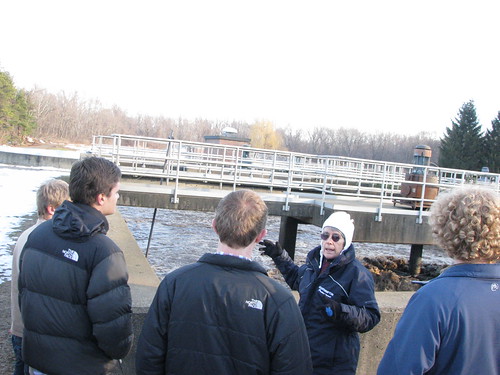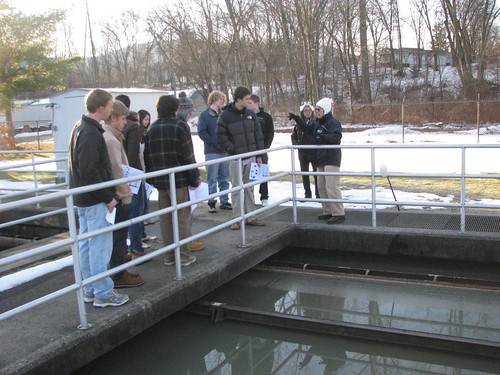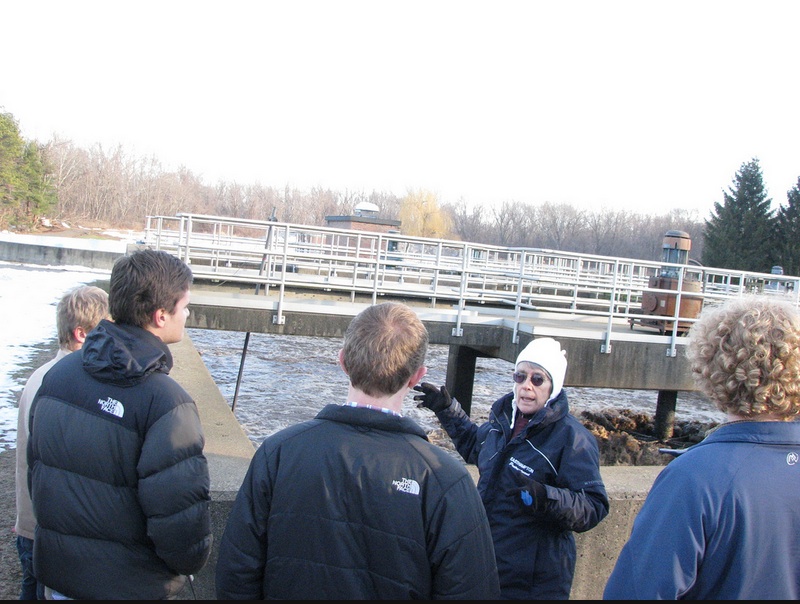We forget about it at the moment it swirls down the drain, as if it were sucked into a dark hole of endless space: once out of sight, it is out of mind. This is how many of us, myself included, think when we take showers or brush our teeth, but is this really how we should think about the water that we use? Shouldn’t we know where our water leads and what happens there? In this article, we will unravel the path across your pipes and the where it goes. Once experiencing the result of your water’s travel, you will believe that every flush counts.
Even though it is a small town, Easthampton produces massive amounts of waste, purifying anywhere from about 1.5 million to 8 million gallons of water in a day. The process of cleaning this dirty water expends many resources itself and it begins with you, when you use water.
Once you flush your toilet, or turn on the faucet to wash your hands, water rushes down massive pipes that transport it to the Easthampton wastewater treatment plant. When your wastewater reaches the treatment plant, it is pushed through a screen, which takes out all the large matter and sends it out into a very large and pungent dumpster. Large, coarse objects like fecal matter and toilet paper are extracted at this step in the process.

Second, the water flows into a few large square pools, called the primary treatment tanks. In these “tanks”, the water sits, allowing for some large and medium sized matter to settle to the bottom as sludge. This sludge is then skimmed from the bottom and disposed of.
Then, it is sent to the aeration tanks, which are large circular open tanks that have turbines spinning, aerating the water. “Bugs”, or protozoa, are added to the water at this point in order to help quicken the breaking down of the remaining organic material.
Then it is sent to the secondary clarifiers. Matter settles into sludge once again, and then a slow screen comes to wipe it away.
Before they send it to the river, it is disinfected with chlorine and sent through a filtration system to get out the chlorine after added. Here, a water sample is occasionally taken and the water is tested for the levels of chemicals and organic matter in the water.
What surprises me most about this process is that most of what the entire plant deals with is water. I always thought that wastewater treatment plants just took out the large particles from the water and then disinfected it, and sent it into the river. I thought it was dealing more with the waste rather than the water. Truly, all the water you use to boil pasta, shower, and brush your teeth remains most of its purity, but since it gets mixed with toilet water and human feces, they have to treat all water like it came from a toilet.

This also goes the same for rainwater. Rainwater is also a difficult reality the treatment plant faces. When there is significant rainfall or snow melt, then more water gets processed by the plant. You may be thinking, Water goes into the ground after it rains, right? That is true, but the water that falls onto pavement in a town like Easthampton does not have anywhere to go. Therefore, civil engineers designed, a long time ago, drains on the sides of roads that allow the water to escape from the streets. These drains eventually lead to the treatment plant. The problem with this is that rainwater, a perfectly pure and drinkable source of water, gets thrown in with the sewage and becomes contaminated. Therefore, when it rains a lot, the treatment plant needs to purify more water in a day, which explains why the amount of water that goes through the system in a day is anywhere from 1.5 to 8 million gallons.
Why is water so precious? Water is a renewable source, and like many people know, most of our earth is made out of water. However, only 3% of that water is fresh water. 2/3 of that bit of freshwater is no use to us: it is either tied up in glaciers, or deep underground, around the north and south poles. With all these reductions made, only 1% of all of Earth’s water is drinkable.
With new technology, drinkable water can be made from salt water, through a process of desalinization. Although you may make the argument that desalination of seawater is a great way to make pure, drinkable water, the process is very unsustainable. Desalination requires lots of energy in order to separate the salt from the water. Desalination is solving the world’s water problems, but if we were to pursue it in greater demand, it would become a leading contributor to global warming, acid rain, and many of today’s pollution problems.
You may also think that your water use only extends to what you consume daily: drinking, cooking, showering, flushing, and brushing. Although the “hard water” that you consume on a daily basis does account for much of your overall use, your choices in what you wear, what kind of car you drive, and what you eat all account for an even greater portion of the water that you use. This, “virtual water” comes mostly from either agriculture, which accounts for 70% of freshwater use, or industry, which accounts for 22% of freshwater use.

In agriculture, estimates of the amount of water is needed to make food is surprising. Most modestly, an ear of corn takes 25 gallons of water to produce. A single cup of milk takes more than 50 gallons to produce. Even greater, a quarter-pound hamburger takes 470 gallons to produce. If you want to further reduce your water usage in the food spectrum, eat vegetarian or vegan: it uses less water because you would be eating primarily from the first trophic level, or plants.
In industry, a single cotton t-shirt takes 520 gallons of water to produce. Think of how many shirts are in your closet. It may seem unreal, but the industry needs water to cool machines down, shape metal, or create the energy needed to engineer machines.
In order to be more conscious about water, we, in general need to use less household water and buy less things. We sometimes forget how much we truly use, so here are some ways to make water conservation a healthy habit in your daily life: put up reminders in your bathroom to use less water and take shorter showers. For example, in my dorm, we have posters in the bathrooms encouraging students to conserve water. Also, you can become vegetarian in order to use less water. You would eat more food from lower down on the food chain, so less water would need to be used to produce your food than meat, which is high on the food chain. If you really like saving water, you can even save the water you use to wash your hands or cook pasta and vegetables as “grey water” and reuse it next time you go to wash your hands or rinse an apple. Finally, consider just buying less things, just what you need so that you reduce the amount of industrial waste.
Everything you buy, everything you eat, and every time you turn on the faucet you are consuming water. Almost everything comes from water. So if you want to start to go green, start with water!



Thanks, Nick, for bringing this important topic to our attention in such a thorough way. In a similar way as calculating our carbon footprint, water usage calculators can be found on line also- a tool to help each person make a measurable difference! Here is one link: http://www.csgnetwork.com/waterusagecalc.html